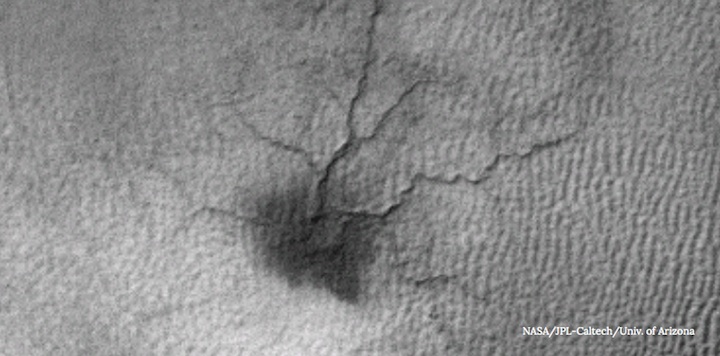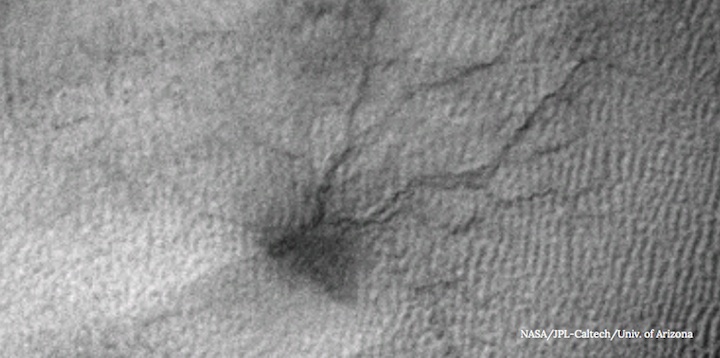NASA/JPL-Caltech/Univ. of Arizona
.



Since arriving in Mars orbit in 2006, NASA's Mars Reconnaissance Orbiter has seen countless weird and wonderful things on the Red Planet's surface. Many features resemble Earth's geology, while others are uniquely Martian, including the bizarre spider-like features that have been seen in the Martian dune fields.
Though well documented, these veined patterns have mysterious origins, defying attempts by the Mars orbiter's High-Resolution Imaging Science Experiment (HiRISE) camera of identifying how they form and spread. HiRISE scientists, who are pretty familiar with seeing the phenomenon, call regions with these spidery structures "araneiform" terrain — a nod to their arachnid shape. Now, researchers have finally spotted the "birth" of one of these spiders and watched it form over three Martian years (one Mars year is equivalent to roughly 1.9 Earth years) and think that it could grow into a large structure that may persist for centuries.
"We have seen for the first time these smaller features that survive and extend from year to year, and this is how the larger spiders get started," said Ganna Portyankina of the University of Colorado, Boulder, in a NASA Jet Propulsion Laboratory statement. "These are in sand-dune areas, so we don't know whether they will keep getting bigger or will disappear under moving sand."
Unlike Earth, Mars is covered with frozen carbon dioxide (commonly known as "dry ice") and sheets of the stuff can be found in polar regions. As the ground warms during spring, solid carbon dioxide locked in the ground will begin to sublimate — it doesn't pass through the liquid phase and instead turns straight to vapor. Sub-surface carbon dioxide gas will then build up pressure, eventually erupting through cracks in the ground creating furrows — basically long, narrow trenches — and this seasonal venting will disturb surface dust. The erosion process, which occurs every season, is responsible for dark fans that appear on the surface and is likely driving the formation of the Mars spiders.
Now, after spotting the genesis of one of these strange-looking features, planetary scientists have a clue as to what triggers them. This particular example was found during spring in the south of Mars, where there's less sand than in the north. Northern seasonal fans (dust that was also ejected after the formation of long furrows) are typically short-lived features, apparently quickly covered and filled in by wind-blown sand. The south, however, seems to allow longer-lived spidery structures to persist.
"There are dunes where we see these dendritic [or branching] troughs in the south, but in this area, there is less sand than around the north pole," said Portyankina. "I think the sand is what jump starts the process of carving a channel in the ground."
Earth's atmosphere is neither cold or thin enough to support the formation of carbon dioxide ice on or below the surface, so these spiders are a very alien concept that cannot occur naturally on Earth. We are watching Mars' landscape undergo fascinating processes, in real time, that we can only see by sending a long-duration satellite to the Red Planet.
Quelle: Seeker
